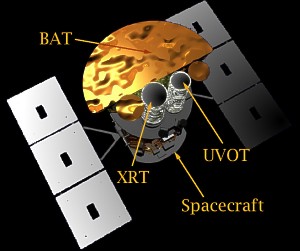
Swift Mission Operations Center
Swift Status
All systems are operating normally.swifttools 3.0.21 Python
module has been released. See
Changelog for
what's been updated! Note this release fixes a bug in the previous version, please update!
The Penn State Swift Team
The Mission Operations Center (MOC) for Swift is located approximately 2.5 miles from the University Park campus of Penn State. The MOC is lead by Mission Director John Nousek, and consists of two teams: the Science Operations Team (SOT) and Flight Operations Teams (FOT).
FOT, lead by Mark Hilliard, perform the crucial engineering tasks necessary to operate the Swift spacecraft, including commanding, downlinking data, and ensuring the health and safety of the spacecraft.
SOT, lead by Jamie Kennea, are in charge of generating observing plans for Swift, handing Target of Opportunity (TOO) requests from the astronomical community, and responding to realtime events such as Gamma-Ray Burst triggers. You're probably here for a TOO request, we got >1700 of them in 2020!
In addition, two of the three instrument teams are lead by Penn State: the Ultraviolet/Optical Telescope (UVOT) lead by Michael Siegel, and the X-ray Telescope (XRT) lead by Jamie Kennea.
The Neil Gehrels Swift Observatory
 The Neil Gehrels Swift
Observatory carries
three instruments to enable the most detailed observations of gamma ray
bursts to date. Two of these instruments, the X-ray Telescope
(XRT) and the UV/Optical Telescope (UVOT) were built by
Penn State and collaborators at Leicester
University and the Mullard Space Science
Laboratory (both in England) and at the
Osservatorio Astronomico di Brera (in Italy).
In addition, Penn State is responsible leads Mission Operations
Center, which operates the satellite.
The Neil Gehrels Swift
Observatory carries
three instruments to enable the most detailed observations of gamma ray
bursts to date. Two of these instruments, the X-ray Telescope
(XRT) and the UV/Optical Telescope (UVOT) were built by
Penn State and collaborators at Leicester
University and the Mullard Space Science
Laboratory (both in England) and at the
Osservatorio Astronomico di Brera (in Italy).
In addition, Penn State is responsible leads Mission Operations
Center, which operates the satellite.
The three coaligned instruments are known as the BAT, the XRT, and the UVOT. The XRT and UVOT are X-ray and a UV/optical focusing telescopes respectively which produce sub-arcsecond positions and multiwavelength lightcurves for gamma ray Burst (GRB) afterglows. Broad band afterglow spectroscopy produces redshifts for the majority of GRBs. BAT is a wide Field-Of-View (FOV) coded-aperture gamma ray imager that produces arcminute GRB positions onboard within 10 seconds. The spacecraft executes a rapid autonomous slew that points the focusing telescopes at the BAT position in typically ~ 50s.
The positions and images derived by the various instruments are sent as soon as they are available from the spacecraft via the TDRSS system to the Gamma Ray Coordination Network (GCN). The GCN broadcasts the results to the world via the Internet for rapid response by the world astronomy community for follow up observations by other ground and space based telescopes. At the next satellite pass over Malindi, the more detailed data is sent to the data center where it will be processed for public access within 30 minutes of the pass.
Recent Swift Operations Statistics
Swift Mission Operations Center
The Pennsylvania State University301 Science Park Road,
Building 2 Suite 332,
State College, PA 16801
USA
☎ +1 (814) 865-6834
📧 swiftods@swift.psu.edu
Swift MOC Team Leads
Mission Director: John NousekScience Operations: Jamie Kennea
Flight Operations: Mark Hilliard
UVOT: Michael Siegel
XRT: Jamie Kennea
Swift Partners
UK: UCL MSSL Univ. of LeicesterUSA: NASA/GSFC LANL Omitron SwRI
Italy: SSDC/ASI INAF OA-Brera